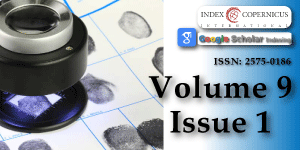Fast identification for Evidences in Crime Scene with Macroscopic Properties and Portable Techniques
Main Article Content
Abstract
In this work we are concerned with identifying visible evidence that can only be observed with the naked eye and is required for experiments by forensic scientists. The search details include many visible physical properties that could be used to explain many unknowns in the crime scene, which means critical truths for different cases. The details include appearance phenomena such as color, odor, shape, size, material type, and inferred properties based on physical appearance. The properties discussed in this work can be further analyzed using specific portable apparatuses that could give very important information about the structure and nature of the properties of evidence in a crime scene. We also deal in this work with general expertise, which forensic scientists should understand and could treat to make the process of identification and characterization in crime scenes be done more systematically in a short time.
Article Details
Copyright (c) 2025 Aljeboree AM, et al.

This work is licensed under a Creative Commons Attribution 4.0 International License.
Aljeboree AM, Radhi IM, AbdulLatif AI, Abdulrazzak FH, Abbas AM, Alkaim AF, Himdan TA, Hussein FH. Review: Synthesis of Chemical Materials for Fingerprint Detection. Int J Innov Sci Res Technol. 2024;9:2720-6. Available from: http://dx.doi.org/10.38124/ijisrt/IJISRT24JUL1675
Rendle DF. Advances in chemistry applied to forensic science. Chem Soc Rev. 2005;34(12):1021-30. Available from: http://dx.doi.org/10.1039/b415890n
Milman BL. Principles of Identification. In: Milman BL, editor. Chemical Identification and its Quality Assurance. Berlin, Heidelberg: Springer; 2011. Available from: https://doi.org/10.1007/978-3-642-15361-7_1
Pratap CE. Recent Trends in Crime Scene Investigation: Inclusion of Forensic Science under New Criminal Law. ISAR J Sci Technol. 2025;3(1):1-5. Available from: https://article.isarpublisher.com/viewArticle/Recent-Trends-in-Crime-Scene-Investigation-Inclusion-of-Forensic-Science-under-New-Criminal-Law
Jang M. Exploring the quantity and type of evidence collected during criminal investigations in South Korea. Forensic Sci Int Synergy. 2024;9:100544. Available from: https://doi.org/10.1016/j.fsisyn.2024.100544
Hawley-Morelos H, Cortes-Perez OI. Crime Scene and Feminicide: Crime Scene Investigation and Processing Standards. In: Cortes-Perez OI, editor. Forensic Victimology and Femi(ni)cide. Cham: Springer; 2024. Available from: https://doi.org/10.1007/978-3-031-72512-8_6
Kleypas DA, Badiye A. Evidence Collection. In: StatPearls [Internet]. Treasure Island (FL): StatPearls Publishing; 2025 Jan–. Available from: https://www.ncbi.nlm.nih.gov/books/NBK441852/
Liang C. Understanding Plastic Deformation: Principles, Mechanisms and Applications. Adv Mater Sci Res. 2024;7(6):229-30. Available from: https://www.openaccessjournals.com/articles/understanding-plastic-deformation-principles-mechanisms-and-applications-18214.html
Caire G, Sano P. EPISD Forensics Team. 2nd ed. 2016. Available from: https://www.newcastle.k12.ok.us/Downloads/EPISD-Forensic-Science_b_v200_hkb_s1.pdf
Trejos T, Koch S, Mehltretter A. Scientific foundations and current state of trace evidence—A review. Forensic Chem. 2020;18:100223. Available from: https://doi.org/10.1016/j.forc.2020.100223
Bräse S, Gil C, Knepper K, Zimmermann V. Organic Azides: An Exploding Diversity of a Unique Class of Compounds. Angew Chem Int Ed Engl. 2005;44:5188-240. Available from: https://doi.org/10.1002/anie.200400657
Belle WV. Fatal Chemical Decomposition Reaction and Explosion at Optima Belle LLC. U.S. Chemical Safety and Hazard Investigation Board; 2023. Available from: https://www.csb.gov/assets/1/6/optima_report_for_publication.pdf
Furstenberg R, Nguyen V, Fischer T, Abrishami T, Papantonakis M, Kendziora C, et al. Advances in sublimation studies for particles of explosives. In: CBRNE Sensing, 2015. Available from: http://dx.doi.org/10.1117/12.2177390
Breshike CJ, Kendziora CA, Furstenberg R, et al. Infrared backscatter imaging spectroscopy of trace analytes at standoff. J Appl Phys. 2019;125(10):104901. Available from: https://doi.org/10.1063/1.5079622
Laska PR. Safety at the Crime Scene. Law Enforc Technol. 1997;24(8):25-8. Available from: https://www.ojp.gov/ncjrs/virtual-library/abstracts/safety-crime-scene
Lease N, Spielvogel KD, Cawkwell MJ, Manner VW. Synthesis and investigation into explosive sensitivity for a series of new picramide explosives. J Energ Mater. 2024:1–21. Available from: https://doi.org/10.1080/07370652.2024.2446882
Stahl H. Forensic Analysis of Lethal Toxin in Criminal Cases. J Forensic Toxicol Pharmacol. 2024;13(4). Available from: https://www.scitechnol.com/peer-review/forensic-analysis-of-lethal-toxins-in-criminal-cases-WvK6.php?article_id=27338
Pautrat M, Barbier E, Lebeau JP. Identifying available substance use disorder screening tests feasible for use in primary care: A systematic review. Prev Med Rep. 2024;38:102610. Available from: https://doi.org/10.1016/j.pmedr.2024.102610
van Asten A. Analytical chemistry in the forensic laboratory. In: Chemical Analysis for Forensic Evidence. Elsevier; 2023. p. 25–64. Available from: https://doi.org/10.1016/B978-0-12-820715-4.00003-1
Franjić S. Forensic Chemistry is an Important Part of any Forensic Investigation. Mathews J Foren. 2022;3(1):10. Available from: https://www.mathewsopenaccess.com/full-text/forensic-chemistry-is-an-important-part-of-any-forensic-investigation
de Araujo WR, Cardoso TMG, da Rocha RG, Santana MHP, Muñoz RAA, Richter EM, et al. Portable analytical platforms for forensic chemistry: A review. Anal Chim Acta. 2018;1034:1-21. Available from: https://doi.org/10.1016/j.aca.2018.06.014
Trombka JI, Schweitzer J, Selavka C, Dale M, Gahn N, Floyd S, et al. Crime scene investigations using portable, non-destructive space exploration technology. Forensic Sci Int. 2002;129(1):1-9. Available from: https://doi.org/10.1016/S0379-0738(02)00079-8
Zhang J, Li F, Yu L, Wang Y, Wang K, Chang C, et al. Research on the explosive characteristics and suppression mechanisms of gas generation during thermal runaway of batteries in a charged state. Chem Eng J. 2025;505:159699. Available from: https://doi.org/10.1016/j.cej.2025.159699
Lennox-Steele A, Nisbet A. A forensic examination of several mobile device Faraday bags & materials to test their effectiveness. In: Valli C, editor. Proc 14th Australian Digital Forensics Conference. 2016;34–41. Available from: https://ro.ecu.edu.au/adf/165/
Committee to Review the IRIS Process; Board on Environmental Studies and Toxicology; Division on Earth and Life Studies; National Research Council. Review of EPA's Integrated Risk Information System (IRIS) Process. Washington (DC): National Academies Press (US); 2014. Chapter 4, Evidence Identification. Available from: https://pubmed.ncbi.nlm.nih.gov/25101400/
Deffenbacher KA. Review of Identification Evidence: A Psychological Evaluation. In: Shepherd JW, Ellis HD, Davies GM, editors. Am J Psychol. 1983;96(4):591–5. Available from: https://www.jstor.org/stable/1422589
Zughaibi TA, Assiri Z, Mirza A, Alharbi H, Alzahrani AE, Alahmadi SA, et al. A Quantitative and Comparative Study of Heroin-Related Metabolites in Different Postmortem Fluids and Tissues. Toxics. 2025;13(3):229. Available from: https://doi.org/10.3390/toxics13030229

